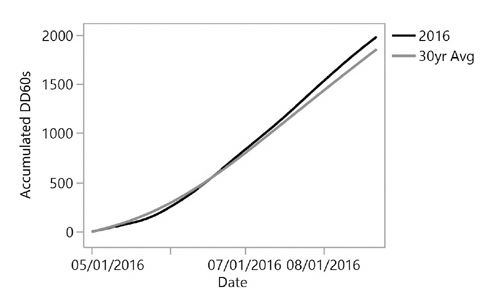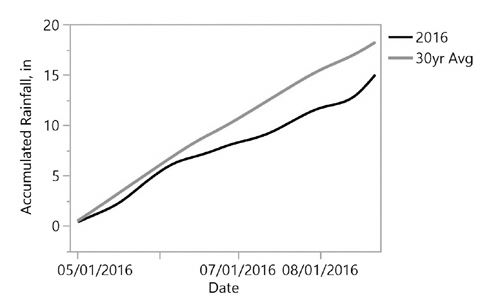|
Cotton Turning . . . Too Soon?
DR. TYSON RAPER
JACKSON, TENN.
The call of the week (beyond target spot) has concerned cotton ‘turning’. In the dictionary of cotton rhetoric, ‘turning’ refers to the shift in canopy color from dark green to shades of yellow and red, or senescence, which usually coincides with the second or third week of football season. Over the past week, the crop has definitely made a turn towards finishing out the season . . . and kickoff for the first game is still a few days away. The general concern is this change has occurred much more rapidly and earlier than we would like. So are we looking at premature senescence and yield penalties?
In order to answer this question, I think we should start by considering three factors from the 2016 season.
The first factor is heat. From looking at the above figure, we can see Jackson, Tenn. is well ahead of the 30 year average for accumulated DD60s- roughly 150 by the 22nd day of August. We had a relatively cool start due to a blackberry winter but since mid-May we have been consistently warmer than normal. Still, 150 heat units above the 30 yr normal only explains roughly a week worth of maturity.
The second factor is slight to moderate drought. From this figure we can see the 2016 season has been relatively dry (all weather data here was collected from the WTREC weather station, but most areas still fall below the 30 year average). We’ve made some gains in the past few weeks but it is easy to see from the 2016 line (blue) that much of Tenn.’s cotton endured slight to moderate drought stress beginning in early June as our crop was squaring. This deficit held through much of the flowering period.
The third factor – and one which is hard to capture in a graph – is the impact of water deficits on nutrient uptake. As water deficits develop, transpiration, root activity and the diffusion rate of nutrients within the soil decline. This year, the water deficit-driven reduction in nutrient uptake coincided with what is typically the most active period of root growth – peak flowering. Many calls over the past week have stemmed from concerns of inadequate applications of potassium (K) or nitrogen (N). This third factor is important to consider in those situations because it help explains how adequate/sufficient applications can be made and deficiencies may still appear as a function of the environment – i.e. resist knee-jerk reactions to fire your consultant, change retailers or double your fertilizer applications based entirely upon nutrient deficiencies observed in 2016.
So. . . it has been hot, it has been dry, and nutrient uptake may have been restricted. Do these three factors mean we are looking at a premature cutout across all of Tenn.? For most of Tennessee’s cotton crop, the answer is no.
Most of our cotton crop experienced ‘primed acclimation’ this year. Basically, we endured periods of slight stress early which helped our crop better prepare for stress later in the season. As a result, the typical Tenn. cotton acre was characterized by fewer nodes above white flowers at the onset of flowering, exceptional fruit retention, and a compact fruiting zone. The large number of bolls retained require a tremendous quantity of resources. In our race-horse, high-yielding, early to early-mid varieties, boll demands frequently trump vegetative structures. Leaves have now begun to forfeit their resources to maturing bolls and plants are beginning to naturally senesce. Plants in some areas had fewer nutrient reserves than normal and all of this has led to a hard (but not necessarily yield penalizing) shutdown.
I’ve walked thin hillsides in the past week that are rapidly defoliating but are holding 6-12 large, nearly mature bolls. With few exceptions, I think we are simply looking at a crop which is senescing in response to a substantial boll load; earliness found us this year. ∆
DR. TYSON RAPER: Cotton & Small Grains Specialist, University of Tennessee.


|
|